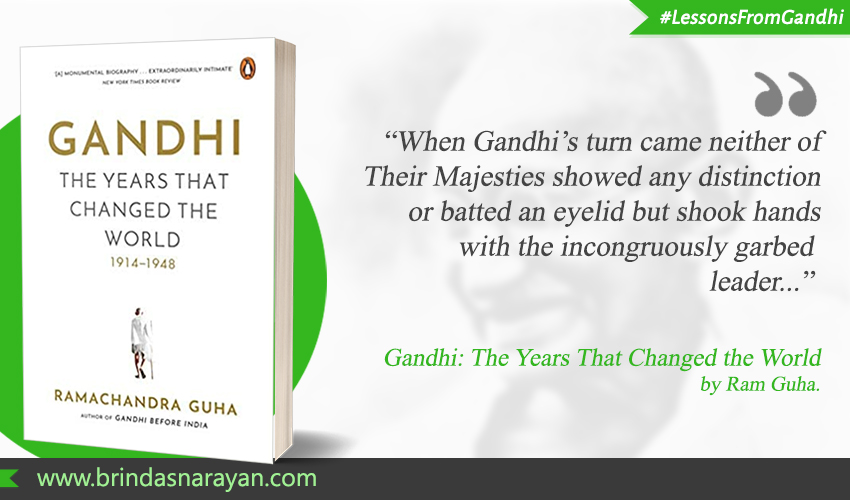
How To Convey More with Less: Communication Lessons From Gandhi
Gandhi, himself, might balk at being called a “brand.” After all, the leader was very explicit about embodying the kind of life that rose above the allure and corruptions of commerce. Despite belonging to the bania community, he might have preferred to flaunt his intellect, or moral persuasions or even his spiritual leanings.
Yet, there are many aspects of his life and persona, that depict his ingenuity in communication. He seemed to possess the knack – well before advertising and public relations had been birthed – to create ‘sticky’ messages, the type that might go viral in our noisy social media world. Or, were transmitted, in his time, by the print media and by word of mouth.
To take one particular instance, when Gandhi was invited by King George V to Buckingham Palace for a tea, the leader insisted on wearing his simple, peasant cottons. This despite, the invitation suggesting that attendees wear “Morning Dress”. At the reception, apparently the King, shook hands with Gandhi without any perceptible distaste.
But later on, according to eyewitness accounts recorded in Ramachandra Guha’s Gandhi: The Years That Changed the World, the King wagged his finger at the inappropriately attired Indian leader and even expressed his disapproval. Gandhi, of course, cheerily deflated the situation and managed to shift the tenor of the conversation to an amicable one.
What is striking about that particular historical meeting is the following:
- Visual Actions are More Memorable than Texts or Speeches: No one seems to have recorded or even remembered exactly what the King said to Gandhi and or what Gandhi said in return. But one cannot forget the clothes Gandhi wore; or the British costumes that he deliberately shunned. It’s the kind of act that’s also easy to transmit with pictures or a video.
- Even With Visuals, Simplicity Can Trump Complexity: Gandhi entered the gilded, overdone Palace with its painted, etched ceilings, and walls hung with pricey artworks, with the simplest form of dissent: by dressing down. There could not have been a more striking setting in which to express his indifference to British norms.
- You Can Simultaneously Communicate Multiple Messages With A Single Action/Visual
- Gandhi’s stance, on that day, can be seen as cheeky, defiant and disrespectful, all of which, the leader must have been acutely conscious of.
- It could also signify humility, naivety and ignorance: By playing into the cliché of a dumb or unknowing ‘native,’ Gandhi was also expressing the colonial view of all Indians. Perhaps we were, he seemed to imply, the uncivilized, brown-skinned heathens. But happily so, and not in need, of any British rescue.
- It could also be seen as polite, collaborative and trusting: he was, after all, entering the King’s turf, unarmed. He was willing to be hosted by the Empire and engage in convivial tête-à-têtes over tea. But all this, at his own terms.
- Integration of Humor Can Aid Recall: Even many British citizens must have been struck by how bizarre Gandhi looked, at a reception where everyone was dressed to the tee. There are varying accounts of how Gandhi responded to journalist questions or jibes about his attire. The oft-repeated one, “The King had on enough for the two of us,” is according to Guha, not backed up by any contemporary source. But there is evidence for another response: “In your country you put on plus-fours; I prefer minus-fours.”
- The Best Messages Transmit Across Age Groups: The story of Gandhi’s meeting with the King can be as easily relayed to mirthful Kindergartners as it can be to a conference filled with ponderous historians. Gandhi also ushered in a childlike prankishness and insouciance to a room filled with stern, stiff upper-lip adults. Could the British empire continue to exude hubris and grandeur when talking to a semi-naked interlocutor?
- Communicating Across Income Classes: Gandhi always had the poorest Indians in mind, while devising his methods. Entering Buckingham Palace in a peasant’s costume was also meant to imbue the most marginalized with self-confidence and pride. Well before Steve Jobs and his ilk ushered in the hip casualness of T-shirts and jeans, Gandhi tried to infuse a nonchalant style of dressing with a stately chic.
References
Ramachandra Guha, Gandhi: The Years That Changed The World, Allen Lane, Penguin Random House India, 2018




